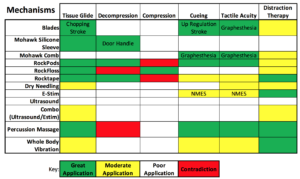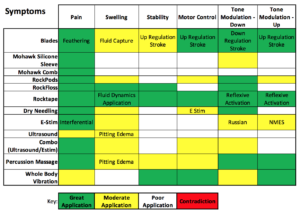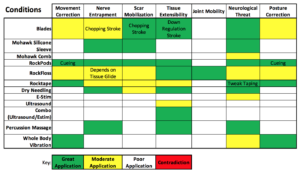by Mitch Hauschildt, MA, ATC, CSCS
I often get asked about how to put all of the different modalities together into an actual treatment program. It can be confusing because we have so many tools at our disposal. We want to avoid the tendency to take a shotgun approach to any treatment, throwing things out and hoping they stick to the wall. We also want to avoid using one treatment on everyone for everything.
“A junior clinician knows the rules. An experienced clinician knows the exceptions”
We want to know the rules and the exceptions for each modality and tool that we have at our disposal. To help simplify the process, I have put together a list of modalities that are used within a lot of clinics. I realize that this isn’t a completely comprehensive list, but it is a good start. Below is a quick overview of each tool:
- Blades IASTM Tools: Depending upon the depth, rate, and other parameters, it can be argued that IASTM tools can be used for treating just about anything. My favorite applications with them are to down regulate tissue in an effort to improve mobility, to up regulate tissue to prime the nervous system and to feather for pain.
- Mohawk Silicone Sleeve Attachment: The Silicone sleeve falls in the category of IASTM tools and it specializes in improving tissue slide and glide by gripping the skin. It isn’t as versatile as the regular blades, but what it does, it does very, very well.
- Mohawk Comb Attachment: Much like the Silicone sleeve, the comb attachment is very much a one trick pony. It is great for pain management.
- Rockpods: The Rocktape version of cupping is great for decompression and cueing for movement correction. I love using them to improve tissue slide and glide via the decompression effect and for providing feedback to specific areas that need up regulation while moving.
- Rockfloss: Floss bands are a bit of a “Swiss Army Knife.” They can be used for a lot of things very effectively. My favorite uses for them are for treating pain and swelling and improving joint stability.
- Rocktape: Kinesiology tape is also very versatile and effective. Depending on the application, it can be used for all kinds of things. My favorite techniques are for improving posture, decreasing pain, up regulating motor control and tweak taping.
- Dry Needling: Dry needling has become my go to for chronic pain and improving tissue extensibility. It is a great way to reset the nervous system.
- Electrical Stimulation: This is another modality that can be used a lot of different ways depending upon settings. I rarely use it for pain control, unless it is in conjunction with dry needling, but I do believe that it has a purpose in our treatment plan for muscle re-education at times.
- Ultrasound: Of everything on the list, I use this modality the least. But, it does have it’s place for some local tissue changes and for treating things like tenosynovitis.
- Combo (Ultrasound/E-Stim): I rarely use this modality as well, but it can be effective for down regulating tone in hypertonic areas of the body.
- Percussion Massage: I have used percussion massagers for years and years as a great way to down regulate painful muscles and decrease tone in hypertonic areas of the body. It can also be great for stimulating Paccinian Corpuscles to up regulate the nervous system and prime it for activity. This is another modality that I have used successfully for a long time. It is great for priming the nervous system, distraction therapy and can also be used to improve mobility.
In an effort to simplify the process, I have put together a few graphics. These aren’t the end-all-be-all. Rather, they are based on my clinical experience. Depending on what you are looking to accomplish, I have put together 3 different graphics.
The first one shows when each modality is most effective for specific mechanisms. By mechanism, I am referring to things that you are trying to accomplish within your treatment. For example, if I want to decompress some tissue, the modalities shaded in green would be my first modality to consider.

In the next graphic, we are looking at the best modalities for various symptoms that we often treat as clinicians:

Finally, here is a short list of some conditions and when I utilize each of the modalities to treat them:

Hopefully this gives you some direction as to when you should implement which modality at the proper time.


Leave a Reply